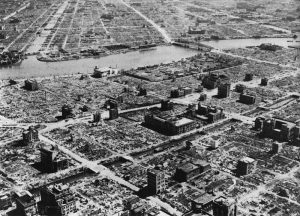Last year, Malcom Gladwell’s “The Bomber Mafia” explored what the author called the “darkest night of the Second World War” – the March 9-10, 1945 firebombing of Tokyo, which killed more than 100,000 Japanese citizens, mostly civilians. Gladwell tries to make sense of what he believes was an unnecessarily destructive attack on the city by framing the story around the careers of two American air corps generals: Haywood Hansell and Curtis LeMay. Gladwell grudgingly admires and respects LeMay, who led the incendiary bombing of Tokyo and other Japanese population centers, but admits that his “heart” is with Hansell, who argued against the area bombing of cities and in favor of more precise bombing of military targets.
Recently, author James M. Scott’s “Black Snow” offered a somewhat different take on the firebombing of Tokyo. Scott is far more sympathetic to LeMay for doing what was necessary to win the war against an enemy regime that repeatedly sacrificed the lives of its soldiers and citizens in a fruitless effort to avoid surrender, and that previously promoted and countenanced mass atrocities in China, the Philippines, Burma, and other places occupied by Japan’s army. Scott considers LeMay one of the great commanders of World War II, who approached his mission with unsentimental realism. LeMay understood, as even Gladwell admits, that Hansell’s precision bombing was a fantasy – the technology of the time and the air environment over Japan (fog, winds, cloud cover, jet stream) simply did not allow for it. And he also understood that daylight bombing – which could help with accuracy – was very costly to U.S. airmen.
Both Gladwell and Scott recount the horrors and terror caused by the use of incendiary bombs in the air assault on Tokyo and other Japanese cities. On March 9-10, 1945, LeMay’s airmen destroyed 16 square miles of Tokyo, including more than 250,000 homes (which left more than a million people homeless). Military and industrial targets were destroyed, but so were schools and hospitals. Tokyo’s residents were burned and scalded by what one survivor called “a blazing hell,” and what one U.S. flyer described as a “sea of flame, a mass of roaring fire that seemed to cover the city like a boiling cauldron.”
LeMay’s airmen went on to bomb 65 more cities in Japan – and still Japan’s leaders would not surrender. It took two atomic bombs and the Soviet entry into the Asian war to finally persuade a reluctant emperor and his government to authorize Japan’s surrender.
While Gladwell acknowledges that “LeMay won the war,” he nevertheless writes that it is “Hansell’s memory … that moves us.” Scott will have none of this. LeMay’s tactics won the war. In the cruel calculation of total war, the bombing (including the atomic bombs) that killed over a quarter-million people, saved millions of Japanese lives and hundreds of thousands of American soldiers’ lives that would have been lost in an invasion of Japan’s main islands.
Gladwell concludes that Hansell, not LeMay, “provides us with a model of what it means to be moral in our model world.” Scott quotes LeMay who told his men: “Leave the glory, the false heroics, and the sentimentality to the actors and sob sisters.” War, LeMay believed, was simple: “You’ve got to kill people, and when you kill enough of them, they stop fighting.” Ironically, in 1964, the Japanese government awarded LeMay the First-Class Order of Merit of the Grand Cordon of the Rising Sun for his assistance with Japan’s air defense program.

































